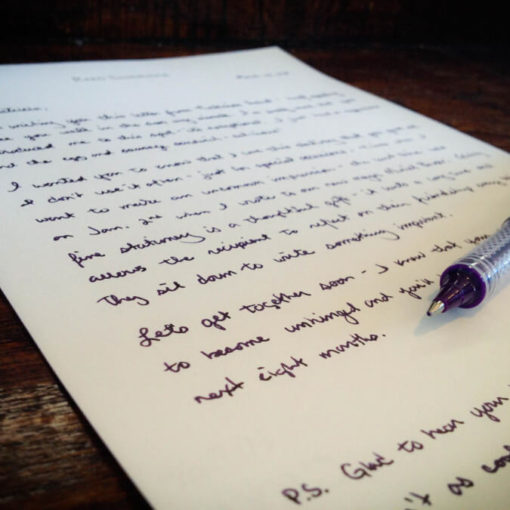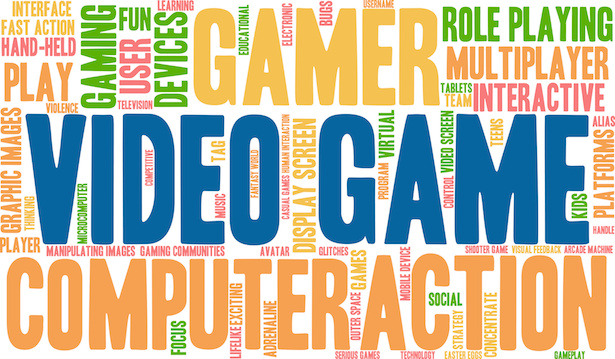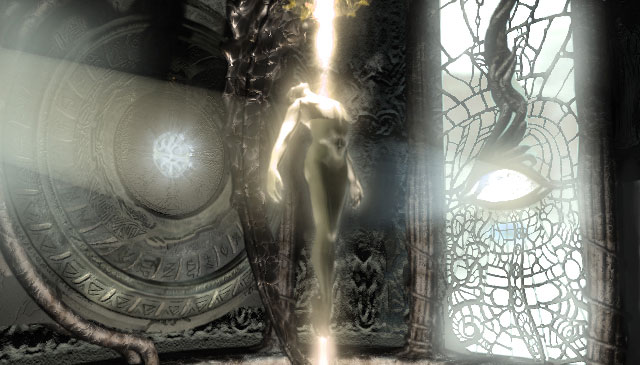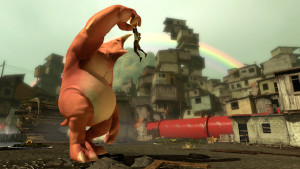 I played Papo & Yo recently, and, as a result, I’ve been thinking a lot about the game’s representation of monstrosity, abuse, and childhood trauma. Sam’s already written about the game’s representation of such things, and she’s noted that the game takes place in an imaginary world in which a young boy named Quico solves puzzles with the help of a toy robot and a big (and volatile) monster friend. And something that has struck me when thinking about this game is the manner in which its imaginary world converses with that of Among the Sleep, a game I’ve written about before and a game that also explores child abuse and monstrous parenting. As such, I’ve been thinking a lot about the similarities and differences between these two games, and I’ve been wondering how such parallels and divergences might speak to the ways games can and do engage with complicated representations of childhood trauma.
I played Papo & Yo recently, and, as a result, I’ve been thinking a lot about the game’s representation of monstrosity, abuse, and childhood trauma. Sam’s already written about the game’s representation of such things, and she’s noted that the game takes place in an imaginary world in which a young boy named Quico solves puzzles with the help of a toy robot and a big (and volatile) monster friend. And something that has struck me when thinking about this game is the manner in which its imaginary world converses with that of Among the Sleep, a game I’ve written about before and a game that also explores child abuse and monstrous parenting. As such, I’ve been thinking a lot about the similarities and differences between these two games, and I’ve been wondering how such parallels and divergences might speak to the ways games can and do engage with complicated representations of childhood trauma.
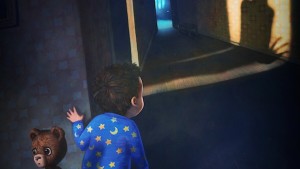 I think there are a lot of really striking parallels between Papo & Yo and Among the Sleep, from the toy sidekicks (the robot in Papo & Yo and the teddy bear in Among the Sleep) to the child protagonists, from the representations of abusive parents as figurative monsters to the imaginary, dreamworld-like settings. Indeed, all these things reveal both games’ use of surrealist landscapes and gameworlds, and I think this surreal imagery is central for the games’ examinations of child abuse.
I think there are a lot of really striking parallels between Papo & Yo and Among the Sleep, from the toy sidekicks (the robot in Papo & Yo and the teddy bear in Among the Sleep) to the child protagonists, from the representations of abusive parents as figurative monsters to the imaginary, dreamworld-like settings. Indeed, all these things reveal both games’ use of surrealist landscapes and gameworlds, and I think this surreal imagery is central for the games’ examinations of child abuse.
Such surrealism is something that Alisha has already discussed in relation to The Flame in the Flood, and she notes its importance in helping her deal with the darker aspects of that game in particular:
When I first encountered the game, the surreal art style was the first thing I noticed, and I’m probably not alone in that. Scout’s angular face, the bright colors, the cartoon-shadow outlines of the wolves, the bright, rushing water of the river she travels, none of it’s real. I keep wondering if that’s the only way I can keep playing without heartbreak, if keeping it all just to the left of reality is the only thing that makes the slow death from sepsis tolerable.
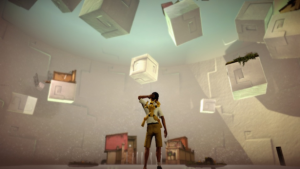 This idea of tolerability, of the surreal’s ability to allow us to “keep playing without heartbreak,” seems vital to the ways we play games like The Flame in the Flood, Among the Sleep, and Papo & Yo—games that center on the intersection of childhood and violence, that feature children who find themselves in violent spaces and situations. As such, it would seem that surreal imagery and stylistics afford us the distance we need to process the traumatic narratives that such games explore.
This idea of tolerability, of the surreal’s ability to allow us to “keep playing without heartbreak,” seems vital to the ways we play games like The Flame in the Flood, Among the Sleep, and Papo & Yo—games that center on the intersection of childhood and violence, that feature children who find themselves in violent spaces and situations. As such, it would seem that surreal imagery and stylistics afford us the distance we need to process the traumatic narratives that such games explore.
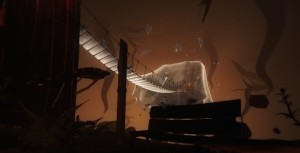 Such distance, and, thus, such an ability to process trauma, is perhaps something that might be lost if these games made use of imagery that was oriented more toward realism than that of the surreal. Indeed, realism, as a mode of representation, aims to highlight so-called “accurate” representations of life, representations without enhancement or embellishment, representations that seek to be more widely understood through what Robert Rebein calls the “authentication of experience.” But how do we even define accuracy, how do we authenticate experience, especially in relation to the experiences of a child? And what would an “accurate” representation of trauma look like? Is there only one way of “accurately” representing childhood trauma, and is realism the primary or only way of doing so? Or can the surreal—its ability to convey irrationality, fragmentation, and emotion (and how such things make manifest experiences of trauma) through the kinds of disjointed dreamscapes and nightmare-worlds of games like Papo & Yo and Among the Sleep—afford us a different means of understanding how an “accurate” experience of childhood trauma might be conveyed?
Such distance, and, thus, such an ability to process trauma, is perhaps something that might be lost if these games made use of imagery that was oriented more toward realism than that of the surreal. Indeed, realism, as a mode of representation, aims to highlight so-called “accurate” representations of life, representations without enhancement or embellishment, representations that seek to be more widely understood through what Robert Rebein calls the “authentication of experience.” But how do we even define accuracy, how do we authenticate experience, especially in relation to the experiences of a child? And what would an “accurate” representation of trauma look like? Is there only one way of “accurately” representing childhood trauma, and is realism the primary or only way of doing so? Or can the surreal—its ability to convey irrationality, fragmentation, and emotion (and how such things make manifest experiences of trauma) through the kinds of disjointed dreamscapes and nightmare-worlds of games like Papo & Yo and Among the Sleep—afford us a different means of understanding how an “accurate” experience of childhood trauma might be conveyed?
I think so, which is not to say that the surreal is necessarily better at conveying such things. But I think that something that the surreal landscapes of Among the Sleep and Papo & Yo allow for is the processing of trauma, and perhaps, then, we might be able to conceive of the surreal, as it is used in these games in particular, as a metafictional strategy.
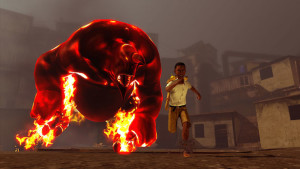 That is to say, if we define metafiction as a self-conscious, self-reflexive strategy for calling attention to the processes of representation and knowledge production, then perhaps the unreality of the surreal can effectively direct our attention to the constructedness of such processes—in other words, it might alert us to the process of constructing such processes. This seems especially relevant when thinking about Papo & Yo, which begins with a dedication from the creator, Vander Caballero, a dedication that reads, “To my mother, brothers and sister, with whom I survived the monster in my father.” Viewing the game through the lens of this dedication, the idea of making use of metafictional self-reflexivity to process one’s own experience with childhood trauma seems inherent in the game’s narrative, and the surreal imagery and landscape through which the game presents this narrative is vital for the game’s exploration of the processing of trauma.
That is to say, if we define metafiction as a self-conscious, self-reflexive strategy for calling attention to the processes of representation and knowledge production, then perhaps the unreality of the surreal can effectively direct our attention to the constructedness of such processes—in other words, it might alert us to the process of constructing such processes. This seems especially relevant when thinking about Papo & Yo, which begins with a dedication from the creator, Vander Caballero, a dedication that reads, “To my mother, brothers and sister, with whom I survived the monster in my father.” Viewing the game through the lens of this dedication, the idea of making use of metafictional self-reflexivity to process one’s own experience with childhood trauma seems inherent in the game’s narrative, and the surreal imagery and landscape through which the game presents this narrative is vital for the game’s exploration of the processing of trauma.
And that’s what makes a game like Papo & Yo really compelling to me—it exemplifies the fact that games can (and do) do so many different things. That games can have so many different purposes, lenses, and modes of representation. That games like Papo & Yo can make use of things like surrealism and metafiction to allow for the processing of childhood trauma. It’s stuff like this that makes the study of games a really exciting and fascinating prospect.

